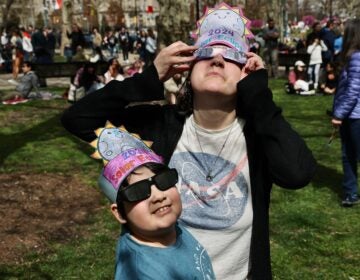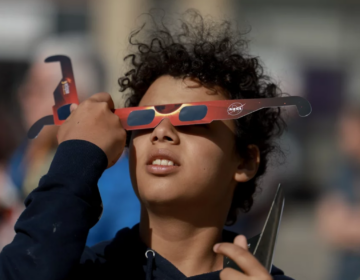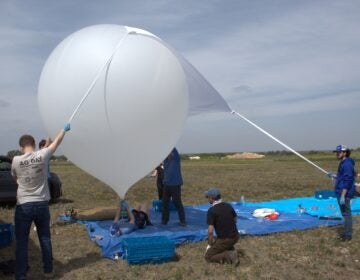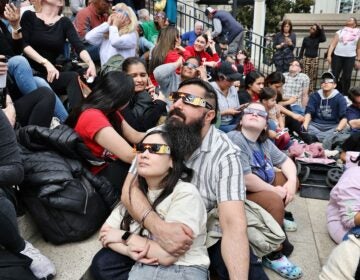Many still manage to spot solar eclipse in Philadelphia area despite clouds
The peak of the solar eclipse is over in the Philly region. Clouds thickened as we reached maximum coverage, but brief breaks in the clouds allowed people to see the event.
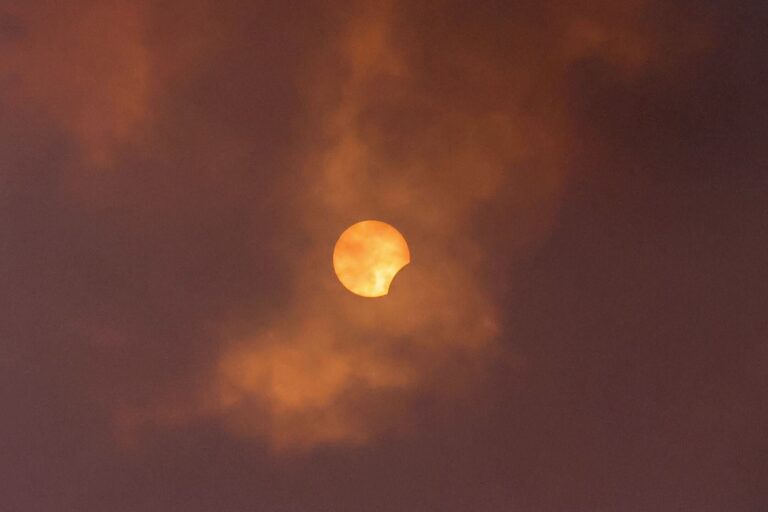
The beginning of the solar eclipse is visible through the roof of a Mylar tent, one of several set up by the Franklin Institute for eclipse viewing. (Emma Lee/WHYY)
This story originally appeared on 6abc.
The peak of the 2024 solar eclipse has come and gone from the Philadelphia region, and your view of the phenomenon depended on whether the clouds would cooperate.
At the Franklin Institute in Center City Philadelphia, the clouds thickened just as we reached maximum coverage.
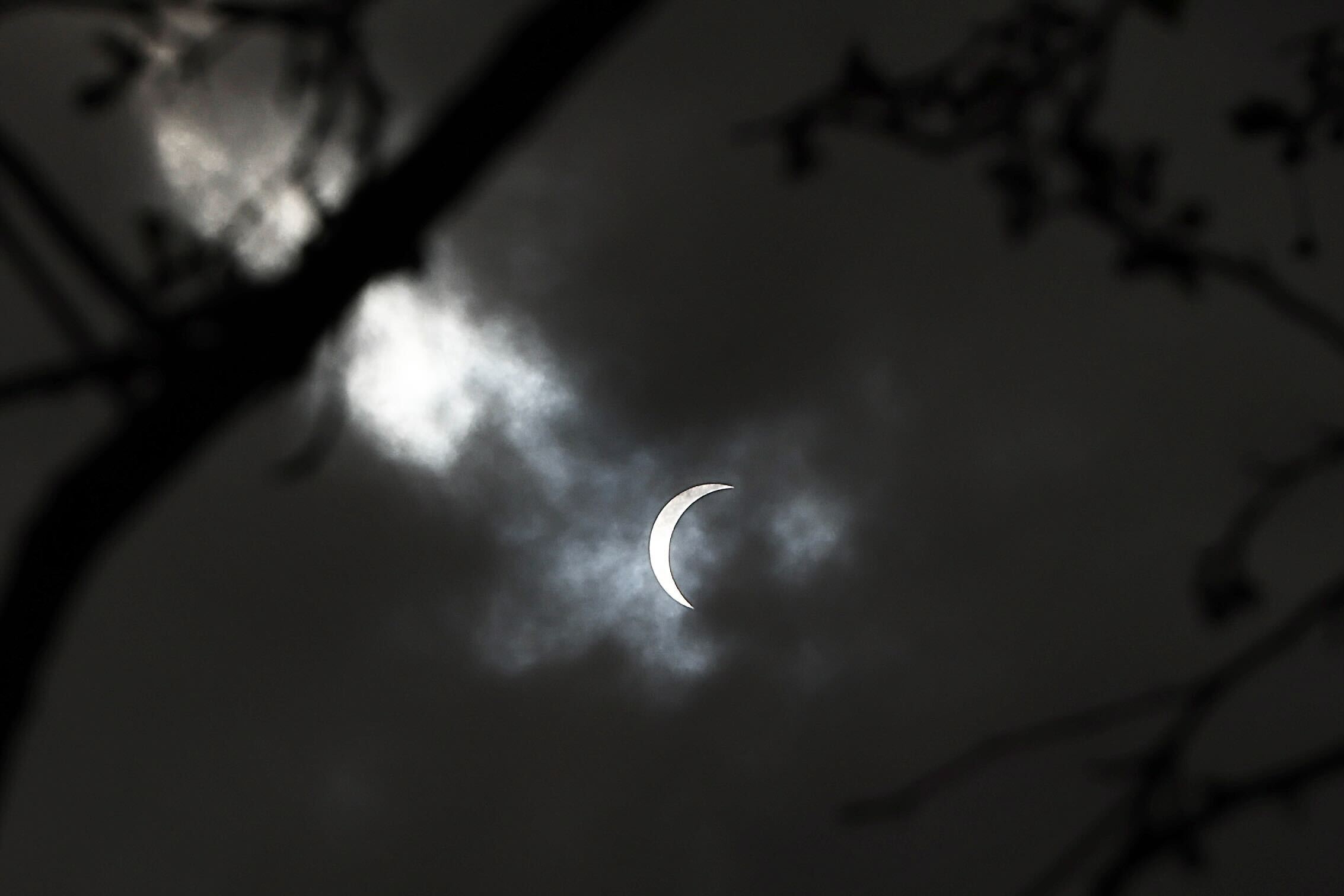
However, some brief breaks in the clouds allowed those gathered there to catch a glimpse.
In fact, so many people came out they ran out of eclipse viewing glasses early.
Meanwhile, Action News was there as people cheered at West Chester University when the clouds broke and the crowd could see the sun and moon — mostly — lining up together.
People fanned out onto the lawn in South Campus to gather together and look into the sky.
“It’s cool to see the unification on campus,” said WCU junior Justin Duffie.
Meanwhile, Paul Rabe says he witnessed his first solar eclipse when he was an 11-year-old in 1965.
“I just loved looking up at the sky,” she said. “I love stars, I love meteors, as far back as I can remember.
While it wasn’t a total eclipse, our area still saw about 90% coverage.
The partial eclipse began at 2:08 p.m., the maximum eclipse was at 3:23 p.m., and it ended at 4:35 p.m.
Wayne Elementary School in Radnor used the rare event as an opportunity to come together.
“We thought that this would be a fantastic opportunity for the kids to come outside and experience something they would be talking about the rest of their lives,” said Asst. Principal Jon Smercky.
Despite some clouds, the kids caught site of the celestial phenomenon and described the event as only elementary students could.
“It’s kind of like a cookie with a bite taken out of it. Like a little one,” said fifth-grader Aina.
“It’s kind of like the sun is a cookie, and the moon is taking a bite out of it,” agreed fifth-grader Jack.
After a nearly seven-year wait, the eclipse created a celestial spectacle in the skies over the United States, as well as parts of Mexico and Canada.
The path of totality across the United States was approximately 115 miles wide, crossing portions of 15 states from Texas to Maine.
An estimated 32 million people live within the path of totality across the U.S., or locations where the moon will completely block the face of the sun from view for a few moments.
The last time there was a total solar eclipse in the Philadelphia area was in 1478, said Dr. Harry Augensen, the professor emeritus of physics and astronomy at Widener University.
“We’re not going to have another eclipse like this one for another 350 years,” Tobin added.
What can we learn from eclipses
Eclipses afford scientists the opportunity to study the sun and how it interacts with Earth in unique ways, and NASA has selected several projects to fund during the total solar eclipse.
“Scientists have long used solar eclipses to make scientific discoveries,” said Kelly Korreck, program scientist at NASA, in a statement. “They have helped us make the first detection of helium, have given us evidence for the theory of general relativity, and allowed us to better understand the Sun’s influence on Earth’s upper atmosphere.”
One project will rely on NASA’s high-altitude research planes to take images of the eclipse from 50,000 feet (15,240 meters) above Earth’s surface to capture previously unseen details in the sun’s corona. The images could also help scientists search for asteroids that orbit near the sun.
Amateur radio operators will try an experiment to see how these phenomena change the way radio waves travel. Operators in different locations will record the strength of their signals and how far they go. Scientists are interested in tracking this distance because the sun directly influences Earth’s upper atmosphere, or ionosphere, which allows radio communications to travel farther. But when the moon blocks the sun, that can change. (Researchers also conducted this experiment during the October 2023 annular eclipse, when the moon didn’t completely block the sun’s light, and the data is still being analyzed.)
Scientists and citizen scientists using the Goldstone Apple Valley Radio Telescope are planning to observe the sun’s most active regions as the moon passes over them during both eclipses.
The sun is currently approaching solar maximum later this year, and scientists are eager to capture this peak of activity through a variety of observations that can only occur during eclipses.
When will the next eclipse occur?
After the total solar eclipse ends, it’s a bit of a wait for the next such celestial sightings in the United States.
Those living in Alaska will catch a glimpse of a total solar eclipse on March 30, 2033, and a partial solar eclipse will shine over most of the U.S. during that event.
A total solar eclipse won’t be visible again from the contiguous US until August 22, 2044, but totality will only occur over North Dakota and Montana, plus northern Canada.
However, the next total solar eclipse with a coast-to-coast path spanning the Lower 48 states will occur on August 12, 2045. The path of totality will arc over California, Nevada, Utah, Colorado, Kansas, Oklahoma, Arkansas, Mississippi, Alabama and Florida, with a partial eclipse visible across other states.
CNN contributed to this post.

Get daily updates from WHYY News!
WHYY is your source for fact-based, in-depth journalism and information. As a nonprofit organization, we rely on financial support from readers like you. Please give today.


